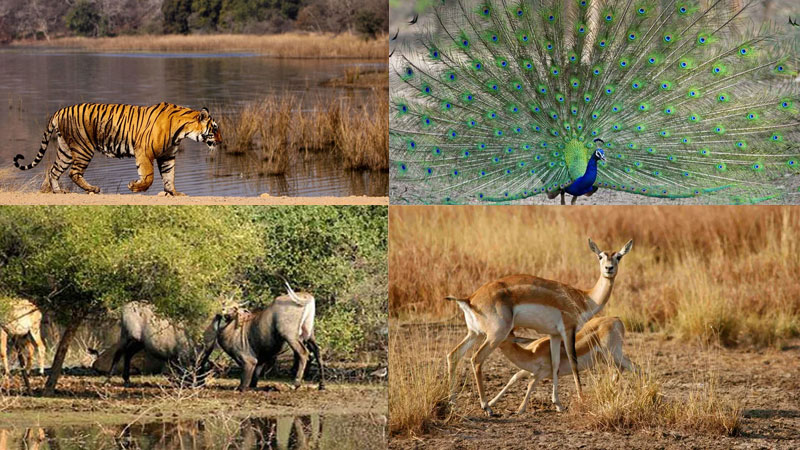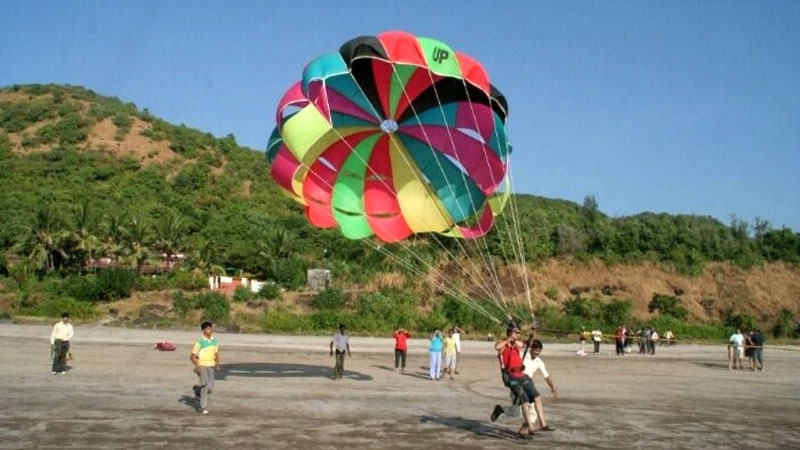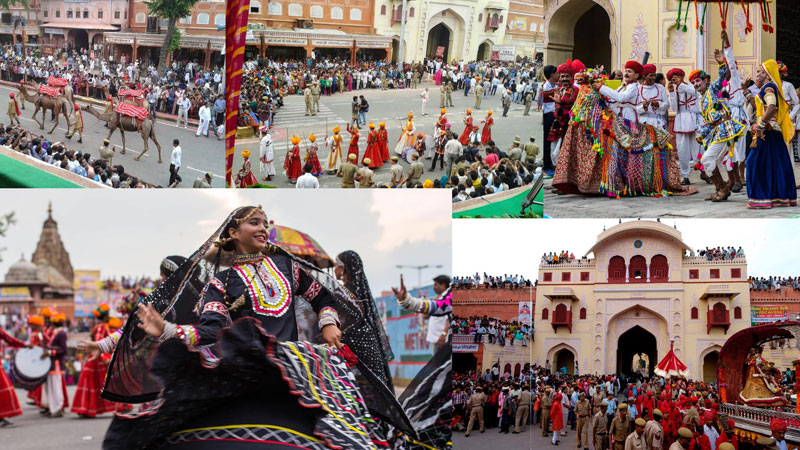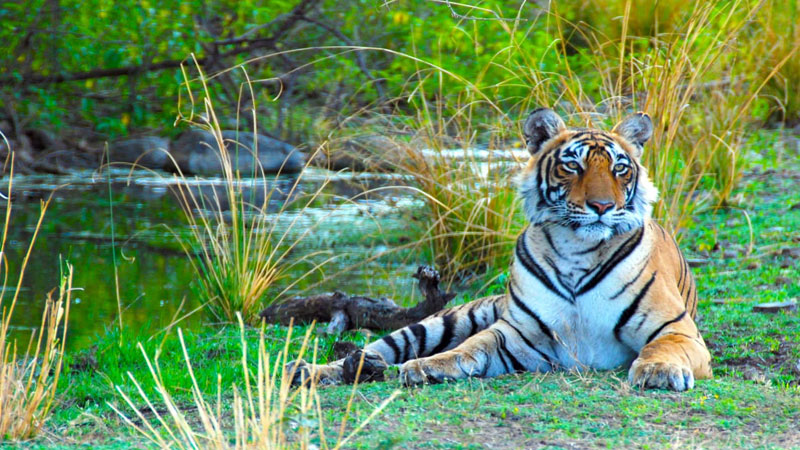Wildlife of Rajasthan
- Home
- About Rajasthan
- Wildlife of Rajasthan

Wildlife of Rajasthan
Rajasthan is a state of the royals and it has numerous evidence of the royal culture in its rich heritage and society. Along with its cultural abundance, Rajasthan also has enough of wildlife beauty in it. Some famous wildlife sanctuaries & national parks in Rajasthan are Ranthambore National Park, Sariska Tiger Reserve, Keoladeo Ghana National Park in Bharatpur, Kumbhalgarh Sanctuary, Sitamata Sanctuary, Tal Chappar Wildlife Sanctuary, Gajner Sanctuary, Mount Abu Sanctuary, Desert National Sanctuary, Darrah Sanctuary and Sajjangarh Wildlife Sanctuary. Major national parks and bird sanctuary are Ranthambore national park, Sariska tiger reserve, and Bharatpur bird sanctuary.
Rajasthan Wildlife means Ranthambore National Park and it is defined through Tigers. And among other creatures you can watch birds like Owlets, the Ubiquitous Langur, Leopard, Caracal, Hyena, Jackal, Jungle Cat, Marsh Crocodiles, Wild Boar, Bears and various species of Deer.
If you are going towards the famous Kumbalgarh Wildlife Sanctuary then you will find Sloth Bear, Wolf, Leopards, Jackal, Hyena, Jungle Cat, Sambhar, Nilgai, Chinkara, Chaisingh and Hare. You can also see birds like Grey jungle Fowl, Peacocks, Doves, Red Spur Owls, Parakeets, Golden Oriole, Grey Pigeons, Bulbul and White Breasted Kingfisher Other wildlife sanctuaries of Rajasthan have their own collection of wild beauties which are to be explored through a long visit in Rajasthan.
Desert National Park
Desert National Park was established in the year 1980 with an objective to preserve both desert flora and fauna. Scores of tourists visit this place so that they can get the glimpses of rolling sand dunes and exotic animal species in the midst of desert landscapes. It is situated in Rajasthan and demonstrates the remarkable ecological biodiversity of the known Thar Desert. The pleasant ecosystem comprises varied flora and fauna, along with rich wildlife that offer a cherished experience through the rugged mountains, cracked land, and sand dunes of the desert.
The charming beauty of stony rocks, roadways and dense salt lake arrests the heart and soul of every visitor who visit this place. The region is a haven for migratory and resident birds of the desert. Many eagles, harriers, falcons, buzzards, kestrel and vultures. Among the birds the Short-toed Eagles, Tawny Eagles, Spotted Eagles, Laggar Falcons and kestrels are the most common among these. Sand grouse are spotted near small ponds or lakes. The endangered Great Indian Bustard is a magnificent bird found in relatively fair numbers in this place. It migrates locally in different seasons. The most suitable time to visit the area is between November and January. The Desert National Park has a collection of fossils of animals and plants of 180 million years back. Some fossils of Dinosaurs of 6 million years old have been found in the area. The Desert National Park is mostly famous for the Indian Blackbuck which is a rare species among the deer’s and antelopes.
Desert National Park Attractions
The vegetation is in scarce, at this place and patches of sewan grass and aak shrub or the Calotropis can be seen. The landscape includes craggy rocks and compact salt lake bottoms, as well as intermediate areas and both fixed and shifting dunes. Around 20 percent of the vast expanse is covered with sand dunes. There are some lakes which are a worth visit in the Desert National Park are Padam Talao Lake, Rajbaugh Lake, Milak Lake are the main water sources for the animals dwelling in this sandy environment.
Keoladeo National Park
Rich of natural flora and fauna, spread in over 29Km2 of area, the Keoladeo National Park (formerly known as the Bharatpur Bird Sanctuary) is a prime attraction for the wildlife and migratory birds and is a World Heritage Site. The Keoladeo national park consists of grasslands, wetlands, woodlands any many other diverse habitats which are home to more than 300 species of birds and floras each, also home to around 50 species of fishes, 13 species of snakes, 7 species of turtles and many more wild animals. The Keoladeo Ghana National Park is a man made and managed wetland area and amongst the best bird areas of the world.
Interesting Facts of Keoladeo National Park
The Keoladeo Park was a being a hunting ground in the times of Maharajas used to be host to a number of Duck shoots organized here by the Maharajas for the British dignitaries. In 1938, then Governor General of India, Lord Linlithgow killed over 4000 birds in one shoot.
The Keoladeo National Park is the only National park in India that is completely covered with a 2 Meter high wall boundary that denies possibilities of any biotic disturbances or any Buffer Zone.
Things to Consider When Planning to Visit Keoladeo Ghana National Park
Do carry a binocular for watching the birds, as its very tough to focus with naked eyes, on the distant birds in the park.
Your personal vehicle will be allowed inside the park but is permitted up to Shanti Kutir only (about 1.7 kilometers inside the gate, at Rs100 per vehicle). After this you can opt to walk, bicycle, or go by cycle rickshaw. Tonga or boats are also available at places where the water level is high.
Khichan Bird Sanctuary
Khichan Bird Sanctuary is located at a distace of 171 kms from Jaisalmer city in the village of Khichan. This natural sanctuary serves as home to three types of birds called Kurjan, Karkara and Kunch that migrate from South West Europe, Black Sea region, Poland, Ukraine, Kazakhstan, North and South Africa and Mongolia. These birds can be seen in large numbers at this bird sanctuary between October and March as they migrate to India during this time to avoid the cold winters of Europe. Khichan Bird Sanctuary is popular world wide as the Demoiselle Crane village.
A large number of these birds visit India every year, however, only about four to six thousand come to the bird sanctuary at Khichan. Kurjan, which makes a typical ‘kur-kur’ sound, weighs 4 to 6 kg and has a height of about three feet. It is for the typical sound they make that they are called Kurjan in the local language. The bird is capable of flying long distances at speeds varying from 40-60 km per hour. Although Kurjans have typical features which make their appearance quite attractive.
Kumbhalgarh Wildlife Sanctuary
Kumbhalgarh Wildlife Sanctuary situated in the Rajsamand District of Rajasthan and surrounds the Kumbhalgarh fortress. The sanctuary spreads across the Aravalli Range, covering parts of Rajsamand, Udaipur, and Pali districts. It is in the region of 105 kilometers from Udaipur city and south of Jaipur. The city of Kumbhalgarh is very well-known for the Kumbhagarh Fort, the most outstanding Fort out of 84 forts, which stood during the Mewar kingdom of Rajasthan. The city is famous for its forts, palaces, temples and wild life sanctuary. The Kumbhalgarh city is one of the main tourist's spot across the globe.
Attractions in Kumbhalgarh Wildlife Sanctuary
Kumbhalgarh Wildlife Sanctuary is home to a very large variety of wild life, and some of them are highly dying out species. The wild life includes wolf, leopards, sloth bear, hyena, jackal, jungle cat, sambhar, nilgai, chausingha or the four horned antelope, chinkara and hare. The bird life at Kumbhalgarh is also enjoyable. The normally shy and untrusting grey jungle fowl can be spotted here. You will also see the peacocks and doves can be seen on a regular basis feeding on grains provided by the jungle guards and caretakers. Bird like the red spur owls, parakeets, golden oriole, grey pigeons, Bulbul, and white breasted kingfisher can also be seen near the water holes. Kumbhalgarh’s natural beauty attracts hundreds of tourists and because of its easy conveyance connectivity from Udaipur, which is 100 km from here. Foot trekking and horse safari organized by local tour operators are proving to be very popular. A typical jungle safari route enters the sanctuary from the Kumbhalgarh Fort and cutting across the sanctuary to reach Ghanerao, and then borders an old abandoned road. On this road, one can sight Chinkaras, Neelgais, four horned Antelope and many birds.
Kumbhalgarh Wildlife Sanctuary is a well-known tourist attraction counted majorly on Rajasthan Tourism. It attracts not only adults but mostly children as it is an abode to a large number of wild species and birds. In this sanctuary tourist can enjoy exclusive jungle safari and gain a great experience especially in the winters.
Mount Abu Wildlife Sanctuary
Mount Abu Wildlife Sanctuary is located in the hill station of Mount Abu which is the only hill station of Rajasthan and one of the oldest mountain ranges of India, the Aravalli range. Mount Abu rises like a tower of ice in the surrounding of green in the middle of the arid zone with its forests, lakes and waterfalls. As it is a rocky area the rocks are igneous and due to the weathering effect of wind and water, large cavities are common in them. Mount Abu Wildlife Sanctuary which is a favorite among nature lovers as it has wonderful prospective for Eco-tourism.
Flora and Fauna
Being a hill station Mount Abu is very rich in floral bio-diversity starting from xenomorphic sub-tropical thorn forests in the foot hills to sub-tropical evergreen forests along water courses and valleys. The sanctuary is rich in herbal medicinal plants also. There are very nearly 81 species of tree, 89 species of shrubs, 28 species of climbers and 17 species of tuberous plants of medicinal significance have been found here. Mount Abu is the only place in Rajasthan where people can see a variety of orchids. The sanctuary is also rich in bryophytes and algae. You can also see about three species of wild roses and sixteen species of feras some of which are quite rare have also been reported from here. The south-west part of the sanctuary is rich in bamboo forests.
As far as the wildlife of Mount Abu Wildlife Sanctuary is concerned then it will not be wrong if saying as a home to various wild species which are disappearing from earth. You can see some of the most unique wildlife here including rare, helpless and endangered species of hyena and jackals which are found in this sanctuary. The past evidences of Mount Abu indicates the presence of lion which was last recorded in 1872 and tiger which was last reported in 1970. In the recent times the leopard is the top killer of the jungle and you can find it in this sanctuary. Other animals found here are sambhar, jungle cat, small Indian civet, wolf, hyena, jackal, Indian fox, common langur, wild boar, pangolin, common mongoose, Indian hare, porcupine and hedgehog. The sanctuary is an ideal environment for the sloth bear too. It is unique thing that more than 250 species of birds are found here, but the beauty of the Mount Abu sanctuary is the grey jungle fowl which distinct it from the others.
Ranthambore National Park
Ranthambore National Park is one of the largest national parks in northern India situated widely in the state of Rajasthan. This wonderful national park is located in the Sawai Madhopur and the wonderful experience lies with the glimpse of the wild animals and plantations. Ranthambore was established as the Sawai Madhopur Game Sanctuary in 1955 by the Government of India, and was declared one of the Project Tiger reserves in 1973. The park is known for its tiger population, and is one of India's Project Tiger reserves. Other major wild animals include leopard, nilgai, wild boar, sambar, hyena, sloth bear and chital. It is also home to wide variety of trees, plants, birds and reptiles. Ranthambore is also the site of one of the largest banyan trees in India. A mix of rolling hills and crags, and meadows, lakes and rivulets, this dry-deciduous forest system is home to an incredible variety of flora and fauna. Apart from the tiger, you can also spot sloth bear, leopard, caracal, jackal, fox, hyena and mongoose at Ranthambore.
Ranthambore History
Many royal guests including Queen Elizabeth II and Prince Phillip came to Ranthambore to shoot tigers during the times for the Maharajas until tiger hunting was banned in 1970. Many of the tiger cubs were separated from their parents due to tiger poaching but Government of India has taken few potential steps to stop this and till 2008 the number of tigers which have been recorded in Ranthambore National Park is 44 and many of the cubs are also taken exclusive care to save the national beauty.
Safari in Ranthambore National Park
The major attraction in the park is following the tiger on safari rides. Rides are carried out at two different times of the day. Each ride takes about three hours. The entire park area has been divided into several zones and the safari vehicles go on one of these zones. Other sites of interest include the majestic fort, built in the 10th-century, towering the park area. The fort stands at a height of 700 feet above the surrounding plain. Inside the fort, there are three red Karauli stone temples devoted to Hindu Gods such as Ganesh, Shiva and Lord Rama. There is a huge lake called Padam Talao is the largest of the all the lakes located inside the park, and the beautiful red sandstone Jogi Mahal is located at the very edge of this lake. A gigantic banyan tree, considered to be India’s second largest, is in the garden of the Jogi Mahal.
There are near about 539 species of flowering plants in the park which adds extra charm to the park. Ranthambore National Park is a home for tigers and many of the flowering species and that is why it is also considered as a National Reserve.
Sajjangarh Wildlife Sanctuary
Sajjangarh Wildlife Sanctuary, which encloses the Sajjangarh palace, was established in 1987 in the city of Udaipur of Rajasthan. It covers an area of 5.19 square kilometers. It is a well-maintained wildlife sanctuary now with solid wall of Kishan Pol protecting the sanctuary. The hillside around the sanctuary is thickly wooded and the former kings of Udaipur maintained this area as a royal shooting preserve. When Udaipur was attacked by the Scindhias in 1764, the hill was used as an artillery dump; and some cannons are still found out here.
Flora and Fauna
The palace oversees the sanctuary, which is a home for reptiles, tigers, nilgai, sambhar, wild boars, hyenas, panthers, and jackals. It is also popular for bird watching. The reserve can be a good trekking point by a trek and also go for a jungle safari as an adventure starting from the Gorilla Point to the Jiyan Sagar or the Bari Lake to enjoy the scenic beauty of the Aravalli hills and the wildlife of the reserve forest.
Attractions in Sajjangarh Wildlife Sanctuary
The major attraction of Sajjangarh Wildlife Sanctuary is an artificial lake named Jiyan Sagar, which is widely known as "Bari Lake" or "Tiger Lake". Maharana Raj Singhji, the ex-ruler of Mewar, made this lake and named it after his mother, Jana Devi. The lake has an area of 1.25 square miles with a storage facility of 400 million cubic feet of water. This is an ideal spot for picnics and swimming as it is a clean lake. You can view herbivores like chital, sambar, blue bull, wild boar, etc. from close quarters in this safari park. A network of jungle roads are created to arrive at diverse parts of the safari park.
From Gorilla viewpoint you can go to Bari Lake through the Maharana Pratap nature trail and can watch the beautiful natural beauty of Aravalli hills along with rich flora and fauna in the area. There is a Jhar Water Hole, which is a constant source of water, is situated on Western phase of Bansdara hills. It is bounded by number of ancient Mahua trees. Near the waterhole, there is a temple dedicated to Lord Shiva. This place is an ideal place to experience the effect of micro-climate with surrounded forest area by sitting at this place. During the rainy season, the springs flowing through the area add the extra beauty to the sanctuary. Sajjangarh Sanctuary is a place rich with wildlife as well as abundance of flora and fauna.
Sariska Tiger Reserve
The Sariska Tiger Reserve is an Indian national park located in the Alwar district of the state of Rajasthan. This area was a hunting preserve of the erstwhile Alwar state and it was declared a wildlife reserve in 1955. In 1978, it was given the status of a tiger reserve making it a part of India's Project Tiger scheme. Many of the wild species are found in this national park are four-horned deer, wild boar, langur, caracal, sambar and chital. It also includes jackal, hyena, jungle cat, leopard, Bengal tiger and some species of birds. This national park's tiger population almost disappeared in the year 2005. However, after some sustained efforts by the Rajasthan state government and WII or Wildlife Institute of India, the disaster was averted.
History
This area has historical legends associated with Maharajas of Alwar including the Sariska Palace. This palace was used to be as the royal hunting cabin of the famous and legendary Maharaja Jai Singh. Sariska Tiger Reserve, once a part of the ancient ‘Matsya’ kingdom is also supposed to have sheltered the exiled Pandavas. It is believed that Bhima smote the rock face of a cliff with his cudgel at Pandu Pol and made a passage through a gorge in the sanctuary as these stories are mentioned in the great Hindu epic of “The Mahabharata”.
Flora and Fauna
The best and the most attractive feature of the Sariska Tiger Reserve has always been its Bengal Tigers. Apart from the Bengali Tiger, Sariska Tiger Reserve includes many wild-lives like leopard, jungle cat, caracal, striped hyena, golden jackal, chital, sambhar, nilgai, chinkara, four-horned antelope ‘chousingha’ wild boar, hare, hanuman langur, Rhesus monkeys, and plenty of bird species and reptiles. Birds include peafowl, grey partridge, bush quail, sand grouse, tree pie, golden-backed woodpecker, crested serpent eagle and the Great Indian Horned Owl.
The various species of trees which are found in Sariska National Park are salar or Boswellia serrata, kadaya or Sterculia urens, dhak or Butea monosperma, gol or Lannea coromandelica, ber or Ziziphus mauritiana and khair or Acacia catechu, Bargad or Banyan or Ficus benghalensis, arjun or Terminalia arjuna, gugal or Commiphora wightii or bamboo can also be met at some places. Shrubs are also found such as kair or Capparis decidua, adusta or Adhatoda vesica and jhar ber or Ziziphus nummularia.
Sariska is also famous for old temples, palaces and lakes such as Pandu Pol, Bhangarh Fort, Ajaibgarh, Pratapgarh, Siliserh Lake and Jai Samand Lake.
Tal Chhapar Sanctuary
Tal Chhapar Sanctuary is a sanctuary located in the Churu district of Bikaner division in Rajasthan. Before independence Tal Chappar sanctuary was a Private Hunting Reserve of the Maharaja of Bikaner. This sanctuary is 210 km from Jaipur on the peripheral of the Great Indian Desert and situated on road from Ratangarh to Sujangarh. The Tal Chhapar sanctuary lies in the Sujangarh Tehsil of Churu District.This sanctuary is a flat saline depression locally known as "Tal" that has a unique ecosystem in the heart of the Thar Desert. Tal Chappar Sanctuary has open grassland with spread all over Acacia and prosopis trees which give it a look of a typical Savanna.
In the Tal Chhapar Sanctuary, a special type of grass is found. The shape of the seed of this grass is like very fine round shaped pearls. For this reason this grass is known as “Mothiya” or pearl and has a very sweet taste. People enjoy eating it, but it is found in very small quantities.
Flora and Fauna
The sanctuary area is mostly covered by grasses with a very few trees. It lies on the way of the passage of many migratory birds such as harriers. These birds pass through this area during September. Birds commonly seen in the sanctuary are harriers, Eastern Imperial Eagle, Tawny Eagle, Short-toed Eagle, sparrow, and Little Green Bee-eaters, Black Ibis and Demoiselle Cranes, which stay there till March. There are many other birds like skylark, crested lark, Ring Dove, brown dove and blue jay are seen throughout the year. Desert fox and desert cat can also be spotted along with typical avifauna such as partridge and sand grouse.
Tal Chappar wild life sanctuary comes alive with the chirping of various migratory birds including montagur’s, marsh harrier, pale harrier, imperial eagle, tawny eagle, short toed eagle, sparrow hawk, skylark, crested lark, ring drove, brown dove, blue jay, green bee- eaters, black ibis and demoiselle or the Kurja cranes. You can also see the Kurja these migratory bird from far off countries as Siberia, Magnolia, Tajikistan, central Asia and starts to migrate in the month of September.
Among the other wildlife beauties then it is a fact that Tal Chhapar Sanctuary is famous for black-bucks. Talchhapar wildlife sanctuary is the sole place having a good population of Black buck in such a small area. The sanctuary is a home to nearly 1680 Black Bucks. Being a natural home of Blackbucks and you can easily see 500-700 animals in a single herd. It is the only sanctuary in India in which is having a good number of blackbucks in an almost tree-less, saline and flat-land. These black bucks have “Mothiya” for their food.




